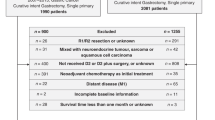Abstract
Background: This study examined prognostic discrimination by lymph node staging for duodenal adenocarcinoma and compared the nodal stage–specific survival with that associated with gastric antral adenocarcinoma.
Method: Prospectively maintained databases from 1983 to 2000 were reviewed to identify 137 patients with duodenal adenocarcinoma and 545 patients with gastric antral adenocarcinoma at a single institution.
Results: R0 resection was performed for 72 patients with duodenal cancer. At least 15 lymph nodes were retrieved in 34 cases (47%). Lymph node metastasis (pN+) was detected in 31 patients (43%). With median follow-up of 36 months, the pN category was an independently significant prognostic factor (pN0, 5-year disease-specific survival of 83%, vs. pN+, 56%; P = .03). The survival difference between pN0 and pN+ was pronounced in patients with ≥15 nodes (100% vs. 47%, respectively; P = .01) but was lost in those with <15 nodes (75% vs. 64%; P = .5). For gastric antrum cancer, 331 patients had R0 resection, and ≥15 nodes were retrieved in 256 cases (77%). Lymph node metastasis was detected in 157 cases (47%). For patients with ≥15 nodes, 5-year survival with pN0 (87%) or pN+ (44%) was not significantly different from the corresponding categories for duodenal adenocarcinoma.
Conclusion: For duodenal adenocarcinoma, examination of ≥15 regional lymph nodes improved prognostic discrimination by the pN category. With accurate nodal staging, pN0 was associated with excellent prognosis. With pN+, prognosis was similar to that for gastric antral adenocarcinoma.
Similar content being viewed by others
REFERENCES
Yeo CJ, Sohn TA, Cameron JL, Hruban RH, Lillemoe KD, Pitt HA. Periampullary adenocarcinoma: analysis of 5-year survivors. Ann Surg 1998; 227: 821–31.
Weiss NS, Yang C. Incidence of histologic types of cancer of the small intestine. J Natl Cancer Inst 1987; 78: 653.
Joesting DR, Beart RW, van Heerden JA, Weiland LH. Improving survival in adenocarcinoma of the duodenum. Am J Surg 1981; 141: 228–31.
Rose DM, Hochwald SN, Klimstra DS, Brennan MF. Primary duodenal adenocarcinoma: a ten-year experience with 79 patients. J Am Coll Surg 1996; 183: 89–96.
Howe JR, Klimstra DS, Moccia RD, Conlon KC, Brennan MF. Factors predictive of survival in ampullary carcinoma. Ann Surg 1998; 228: 87–94.
Fong Y, Blumgart LH, Lin E, Fortner JG, Brennan MF. Outcome of treatment for distal bile duct cancer. Br J Surg 1996; 83: 1712–5.
Conlon KC, Klimstra DS, Brennan MF. Long-term survival after curative resection for pancreatic ductal adenocarcinoma: clinicopathological analysis of 5-year survivors. Ann Surgery 1996; 223: 273–9.
Brennan MF. Duodenal cancer. Asian J Surgery 1990; 13: 204–9.
Siewert JR, Bottcher K, Stein HJ, Roder JD. Relevant prognostic factors in gastric cancer: ten-year results of the German gastric cancer study. Ann Surg 1998; 228: 449–61.
Karpeh MS, Leon L, Klimstra D, Brennan MF. Lymph node staging in gastric cancer: is location more important than number? An analysis of 1038 patients. Ann Surg 2000; 232: 362–71.
Flemming ID, Cooper JS, Henson DE, et al. AJCC Cancer Staging Manual. 5th ed. Philadelphia: Lippincott-Raven, 1997.
Sexe RB, Wade TP, Virgo KS, Johnson FE. Incidence and treatment of periampullary duodenal cancer in the U. S. veteran patient population. Cancer 1996; 77: 251–4.
Bakaeen FG, Murr MM, Sarr MG, et al. What prognostic factors are important in duodenal adenocarcinoma. Arch Surg 2000; 135: 635–42.
Sohn TA, Lillemoe KD, Cameron JL, et al. Adenocarcinoma of the duodenum: factors influencing long-term survival. J Gastrointest Surg 1998; 2: 79–87.
Ryder NM, Ko CY, Hines OJ, Gloor B, Reber HA. Primary duodenal adenocarcinoma: a 40-year experience. Arch Surg 2000; 135: 1070–5.
Kaklamanos IG, Bathe OF, Franceschi D, Camarda C, Levi J, Livingstone AS. Extent of resection in the management of duodenal adenocarcinoma. Am J Surg 2000; 179: 37–41.
Feinstein AR, Sosin DM, Wells CK. The Will Rogers phenomenon: stage migration and new diagnostic techniques as a source of misleading statistics for survival in cancer. N Engl J Med 1985; 312: 1604–8.
Bunt AM, Hogendoorn PC, van de Velde CJ, Bruijn JA, Hermans J. Lymph node staging standards in gastric cancer. J Clin Oncol 1995; 13: 2309–16.
Bunt AM, Hermans J, van de Velde CJ, et al. Lymph node retrieval in a randomized trial on western-type versus Japanese-type surgery in gastric cancer. J Clin Oncol 1996; 14: 2289–94.
Ohigashi H, Ishikawa O, Tamura S, et al. Pancreatic invasion as the prognostic indicator of duodenal adenocarcinoma treated by pancreaticoduodenectomy plus extended lymphadenectomy. Surgery 1998; 124: 510–5.
Macdonald JS, Smalley SR, Benedetti J, et al. Chemoradiotherapy after surgery compared with surgery alone for adenocarcinoma of the stomach or gastroesophageal junction. N Engl J Med 2001; 345: 725–30.
Author information
Authors and Affiliations
Corresponding author
Rights and permissions
About this article
Cite this article
Sarela, A.I., Brennan, M.F., Karpeh, M.S. et al. Adenocarcinoma of the Duodenum: Importance of Accurate Lymph Node Staging and Similarity in Outcome to Gastric Cancer. Ann Surg Oncol 11, 380–386 (2004). https://doi.org/10.1245/ASO.2004.05.021
Received:
Accepted:
Issue Date:
DOI: https://doi.org/10.1245/ASO.2004.05.021




